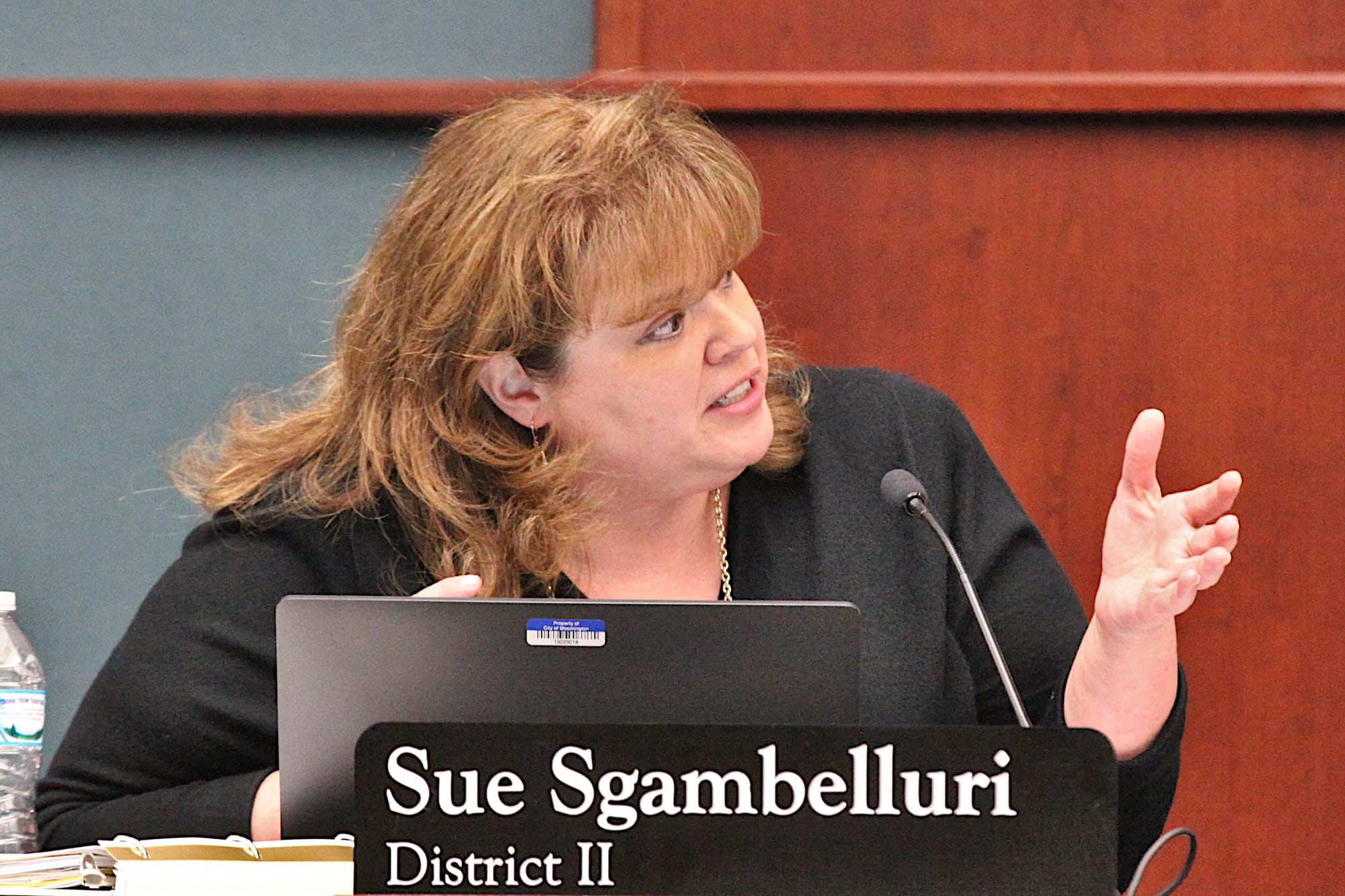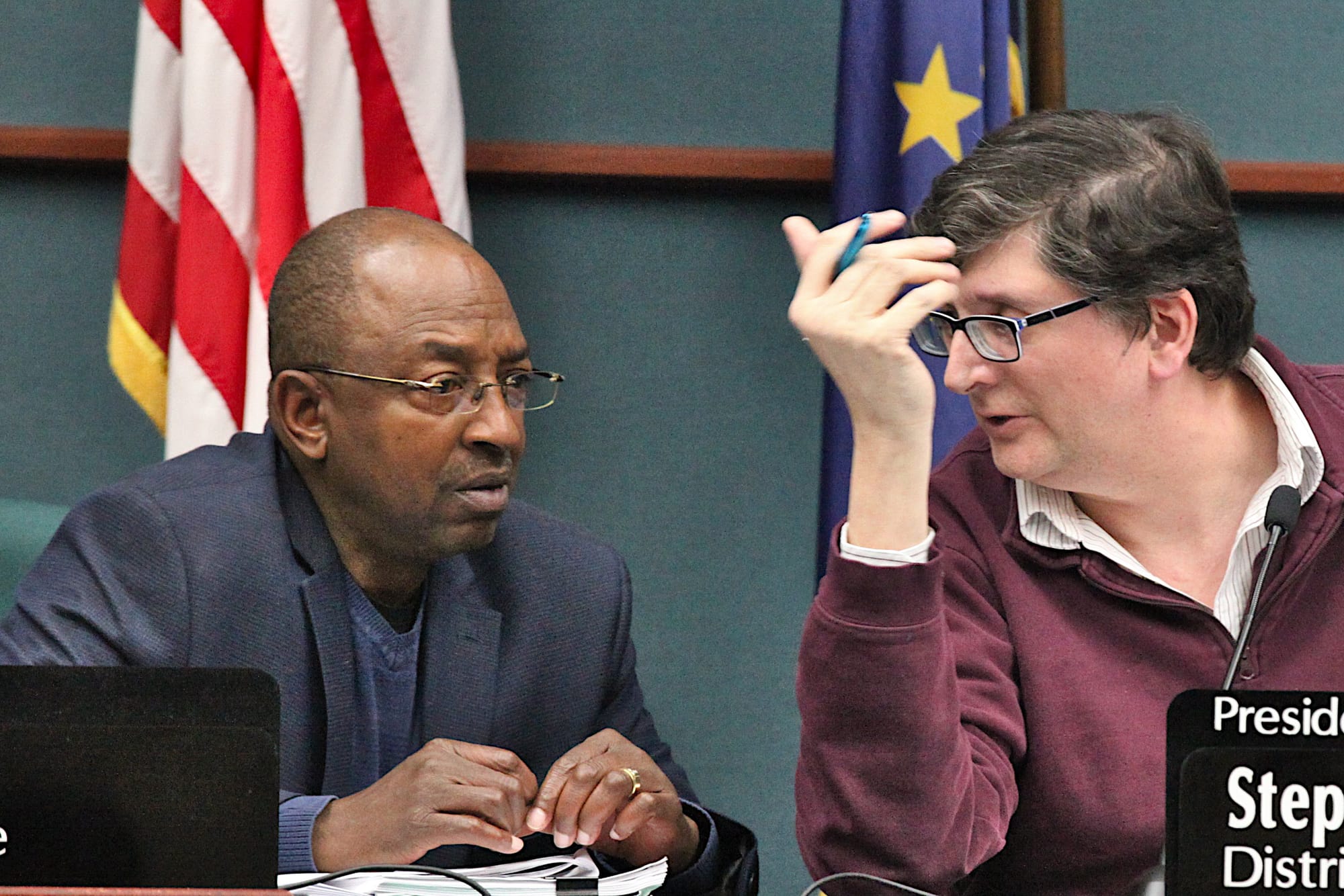Bloomington city council creates standing committees on 5–4 vote




Left: Sue Sgambelluri. Middle: Jim Sims and Steve Volan. Right: Dave Rollo.
At Wednesday’s regular meeting, after about two hours of deliberation, Bloomington’s city council voted 5-4 to establish eight new four-member standing committees.
Wednesday’s vote means that after a first reading of a new local law, the council will now have the option of referring the legislation to any of the standing committees for further consideration. And as one consequence of local code, a standing committee can meet twice on a referred proposal, before it has to report back to the full council.
In contrast, the committee of the whole is required to report back to the council at the conclusion of a single meeting. It’s typically been the committee of the whole that has met between first and second readings of a proposed new local law to give it more scrutiny.
The ability to meet twice before reporting back to the full council is one argument for the standing committee proposal, because it could make individual meetings shorter. The idea is to trade individual meetings that are longer on clock time for a legislative process that might be longer on calendar time.
The other role that standing committees will play is that of oversight and liaison to various city departments. The argument for standing committees based on this role is that it gives the local legislature a tool to check the executive.
It’s that role that led to strong opposition to the proposal among city department heads when it was first introduced. By Wednesday their concerns about having the council acting in a supervisory role were allayed, according to remarks from deputy mayor Mick Renneisen at Wednesday’s meeting. Remaining are staff concerns about the possibility of increased work load to support the work of standing committees.
Now created are the following committees, in addition to the existing land use committee: administration; community affairs; housing; public safety; social services; climate action and resilience; sustainable development; transportation; and utilities and sanitation.
The standing committee proposal, which is a resolution, not an ordinance, was introduced by council president Steve Volan, on Jan. 8, the council’s organizational meeting. It was subsequently put off until Jan. 29, then again until Wednesday. The council held three work sessions on the topic, on Jan. 3, Jan. 10 and Feb. 14.
Up to now, the only standing committee that has been a routine part of the council’s legislative process is the land use committee, which handles planned unit development proposals (PUDs). PUDs are changes to zoning, which need council approval.
The members of the land use committee all voted in favor of the standing committee proposal. Besides Volan, the committee includes Matt Flaherty, Isabel Piedmont-Smith, and Kate Rosenbarger. Providing the one extra vote to get to the required five-vote majority was Sue Sgambelluri.
Flaherty, Rosenbarger and Sgambelluri started their first terms of councilmembers at the beginning of the year. So among the newer councilmembers, that made for 3–1 support. Ron Smith, the fourth new councilmember, voted against establishing standing committees.
Volan and Piedmont-Smith were the only two of the five veteran members of the nine-member council who supported the proposal. Dave Rollo, Jim Sims and Susan Sandberg voted against it.
In opposing the creation of additional standing committees, Sandberg read aloud a prepared statement that concluded a pitch to the newer councilmembers—to give themselves a year to become more familiar with the annual legislative cycle, and revisit the question next January at the beginning of their second year of service. Councilmembers serve four-year terms.
Sandberg also objected to the idea that standing committees provide a chance for councilmembers to specialize in a particular topic: “As to councilmembers self-selecting into specialized committees of primary interest, I would suggest that every single piece of business and legislation that comes before this representative body should be of prime interest to all nine of us.”
The value of having the collective wisdom of nine councilmembers present at a committee meeting that takes places between first and second readings of legislation was something Dave Rollo cited as a benefit to the committee-of-the-whole-based approach, compared to four-member committees.
Rollo also made a different argument based on the presence of nine councilmembers at a committee-of-the-whole meeting—from the perspective of the public. If the committee meeting between first and second readings of legislation is that of a standing committee, then it means the only chance for a member of the public to address all nine-councilmembers about the legislation is at the second reading, which comes at a regular meeting of the full council. If the intervening committee meeting is a meeting of the committee of the whole, then a member of the public has two opportunities to address all nine councilmembers on the topic.
One of the arguments for using standing committees as a part of the legislative process, instead of the committee of the whole, is based on scheduling. Under existing local code, standing committees have to meet on Wednesday evenings, and sequentially—so that anyone can attend any of the committee meetings.
Three standing committee meetings scheduled sequentially were argued by Volan and other supporters to be superior to a single meeting of the committee of the whole. The idea is that three committee meetings, with published start and stop times, allow someone who is interested in just one of the topics, or for staff who have to appear for a particular item, to manage their evening better.
On Wednesday, Rollo refuted that as a benefit of separate standing committee meetings, pointing out that the same benefit could be achieved by indicating the clock times for items on the agenda of a single meeting.
Wednesday’s deliberations on standing committees included seven roll-call votes, all of them unanimous, except for the final vote on passage. One of the votes was to suspend the rules so that an amendment to an amendment could be further amended.
The amendment to the amendment to the amendment involved renaming a proposed new committee from “sustainable growth and development committee” to simply the “sustainable development committee.” Rollo proposed the change because, he said, the notion of “sustainable growth” is oxymoronic. The main obstacle to getting the change made was sorting through the parliamentary maneuvers necessary—like suspending the rules.
What made the layers of amendments one deeper than they would have been was Volan’s proposal to make a raft of changes from his initial proposal on Jan. 8 through an “amendment by substitution.”
In the legislative process from now on, the city council will still have the option under local code to refer a proposed new law to its committee of the whole instead of a four-member standing committee. But a motion to refer a matter to a standing committee has to be considered before a motion for referral to the committee of the whole.
There is no code requirement that a new law be referred to a committee at all before it gets a vote at second reading. The basic code requirement is that every new local law has to get two readings in front of the council and can’t be passed on the same day or the same meeting when it gets first read. The one exception is if passage is “by unanimous consent of the members present, at least two-thirds of the members being present and voting.”




Comments ()